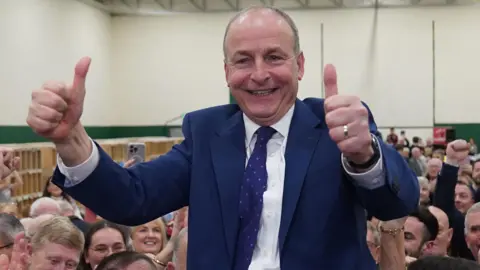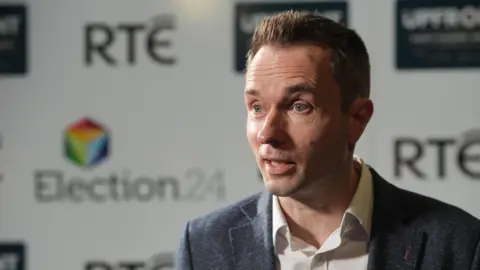 PA Media
PA MediaFianna Fáil has won the most seats in the Dáil (lower house of parliament) following the Republic of Ireland’s general election.
It won 48 seats while Sinn Féin – the main opposition party in the last Dáil – won 39.
Fine Gael, which has been in coalition with Fianna Fáil since 2020, was third with 38 seats.
Those two parties seem best placed to form a new government, but Sinn Féin insists it will still be involved in the coalition talks.
Candidates fought it out for 174 seats in the Dáil, with 88 needed to secure a majority.
Fianna Fáil and Fine Gael combined have 86.
First preference percentage share for the largest three parties was: Fianna Fáil 21.9%, Fine Gael 20.8%, Sinn Féin 19.0%.
Turnout for the election was 59.7%, the lowest in more than a century.
Fianna Fáil’s deputy leader Jack Chambers told RTE’s Morning Ireland on Monday that he did not expect a new government to be formed before Christmas.
But he said he did not expect talks to take five months like the last time.
Fianna Fáil and Fine Gael junior coalition partner, the Green Party, had a disappointing election, dropping from 12 seats to just one.
Who could form the next government?
To return to government, Fianna Fáil and Fine Gael have a number of options, including doing a deal with Labour or the Social Democrats – who each won 11 seats – or trying to strike an agreement with the right-wing party Independent Ireland, which has four seats.
Another option would be to work with a combination of some of the 16 independent politicians, two Aontú TDs (MPs) or the single TD from the 100% Redress Party.
The frontrunner to be the next taoiseach (Irish prime minister) is Fianna Fáil leader Michéal Martin.
Nothing at this stage can be ruled out as weeks, if not months, of political talks are now likely.
Labour TD Marie Sherlock said her party would not go into government with Fianna Fáil and Fine Gael alone without other smaller parties.
“There is no circumstance that I can envisage that the Labour Party will be going into government with Fianna Fáil and Fine Gael. We can only form a basis for negotiation if we’re with other small parties,” Sherlock told RTÉ.
Eoin Ó Broin, Sinn Féin TD for Dublin Mid West, said his party was keen to talk to other “progressive parties”.
He emphasised that “no deal has been done yet”.
“Fianna Fáil and Fine Gael clearly would prefer to go in with each other, despite the cost that it’ll have for the general population but they haven’t formed a government yet,” he said.
“It’s incumbent on us to meet with other likeminded parties to see how we can ensure that those really urgent pressing issues for people, housing, healthcare, cost of living, remain at the centre of the agenda.”
Chambers, who was re-elected in the Dublin West constituency, said his party was “very clear” on its position with Sinn Féin.
“There is no common ground when it comes to substance in policy,” he added.
Speaking to the BBC’s Good Morning Ulster, he said: “We’re going to significantly increase our representation here in the capital of Dublin and indeed across the country.
“And we will have a greater level of representation in the next Dáil than we did in the last one, and that’s having served in government when we had serious economic challenges.”
‘Working well together’
Among the new TDs is Fine Gael’s Emer Currie.
The former Irish senator is a daughter of the late Northern Ireland politician Austin Currie, who co-founded the Social Democratic and Labour Party.
“He would have been absolutely delighted,” Currie told Good Morning Ulster, adding that her election was a “very special” moment for her whole family.
With her party in line to return to government, Currie said the result of the election seemed to indicate that the public was content with the status quo.
“It’s a statement that they felt that Fine Gael and Fianna Fáil were working well together,” she said.
Meanwhile, Cian O’Callaghan, deputy leader of Social Democrats, said there was a “possibility of a coalition with left parties in it” but due to the results so far, a left only government would not be possible.
Callaghan has been re-elected in Dublin Bay North.
Responding to claims that the left failed to coalesce their argument before the election, O’Callaghan said: “I think every party needs to stand on their own two feet and make the case to the electorate as to why people should vote for them.
“The reason we have different parties is because there is differences and it gives people a different choice as well in the election.”
 PA
PAGreens ‘lost all but one’
 Niall Carson/PA Wire
Niall Carson/PA WireThe Green Party will be “very disappointed” in their results according to Lisa Keenan, assistant professor of political science at Trinity College, Dublin.
“They were going into in this election with 12 seats, they’ve lost all but one,” she said.
“They were perceived to be lucky to hold on to that one – that’s the seat of their leader Roderic O’Gorman.
“And I think for them it’s a little bit tough to take in a sense that in government they achieved many, many important policy wins.”

